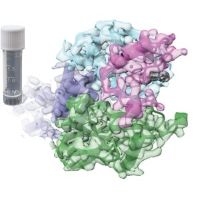Specification
| Description | Recombinant protein from the full-length sequence of Homo sapiens ring finger and CHY zinc finger domain containing 1 (RCHY1), transcript variant 1 (NM_015436). |
| Organism | Homo sapiens (Human) |
| Expression Host | Human Cells |
| Tag Info | His or DYKDDDDK. Please contact us if you need further information or require specific designed tag. |
| Purity | Greater than 90% by SDS-PAGE gel |
| Uniprot ID | Q96PM5 |
| Entry Name | ZN363_HUMAN |
| Gene Names | RCHY1 ARNIP CHIMP PIRH2 RNF199 ZNF363 |
| Alternative Gene Names | ARNIP CHIMP PIRH2 RNF199 ZNF363 |
| Alternative Protein Names | RING finger and CHY zinc finger domain-containing protein 1 (EC 2.3.2.27) (Androgen receptor N-terminal-interacting protein) (CH-rich-interacting match with PLAG1) (E3 ubiquitin-protein ligase Pirh2) (RING finger protein 199) (RING-type E3 ubiquitin transferase RCHY1) (Zinc finger protein 363) (p53-induced RING-H2 protein) (hPirh2) |
| Application | Antigens, Western, ELISA and other in vitro binding or in vivo functional assays, and protein-protein interaction studies; For research & development use only! |
| Buffer | Purified protein formulated in a sterile solution of PBS buffer, pH7.2, without any preservatives |
| Endotoxin | Endotoxin level is < 0.1 ng/µg of protein (<1EU /µg) |
| Length | 261 |
| Molecular Weight(Da) | 30110 |
| Protein Sequence | (The sequence of expressed protein may have some variation from the sequence shown below. Please contact us for the exact sequence.) MAATAREDGASGQERGQRGCEHYDRGCLLKAPCCDKLYTCRLCHDNNEDHQLDRFKVKEVQCINCEKIQHAQQTCEECSTLFGEYYCDICHLFDKDKKQYHCENCGICRIGPKEDFFHCLKCNLCLAMNLQGRHKCIENVSRQNCPICLEDIHTSRVVAHVLPCGHLLHRTCYEEMLKEGYRCPLCMHSALDMTRYWRQLDDEVAQTPMPSEYQNMTVDILCNDCNGRSTVQFHILGMKCKICESYNTAQAGGRRISLDQQ |
Background
| Function | FUNCTION: Mediates E3-dependent ubiquitination and proteasomal degradation of target proteins, including p53/TP53, P73, HDAC1 and CDKN1B. Preferentially acts on tetrameric p53/TP53. Monoubiquitinates the translesion DNA polymerase POLH. Contributes to the regulation of the cell cycle progression. Increases AR transcription factor activity. {ECO:0000269|PubMed:16914734, ECO:0000269|PubMed:17721809, ECO:0000269|PubMed:18006823, ECO:0000269|PubMed:19043414, ECO:0000269|PubMed:19483087, ECO:0000269|PubMed:21791603, ECO:0000269|PubMed:21994467}. |
| Pathway | Protein modification; protein ubiquitination. |
| Protein Families | |
| Tissue Specificity |
QC Data
| Note | Please contact us for QC Data |
| Product Image (Reference Only) |  |

